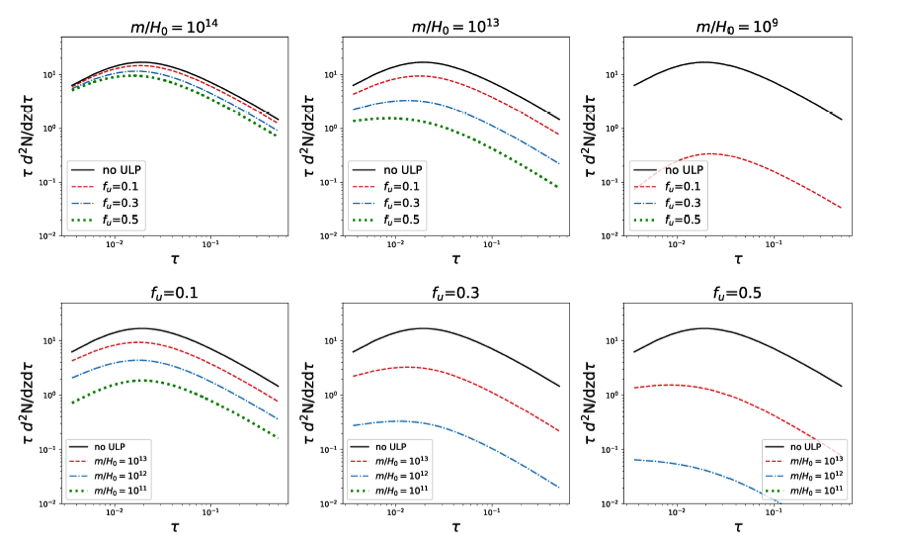云南大学中国西南天文研究所研究团组提出利用21厘米森林观测约束超轻暗物质粒子的性质
Constraining the nature of ultra-light dark matter particles with observations of 21cm forest
超轻标量场粒子可以普遍地通过近似对称性自发破缺而产生,如轴子以及更为一般的超轻粒子(ULPs)。除了粒子物理学,这类粒子也对宇宙学的研究意义重大,其能够贡献暗物质粒子丰度,影响sub-Mpc尺度的结构形成。
近日,由云南大学中国西南天文研究所Hayato Shimabukuro博士领导的一个合作团队提出一个全新的、基于21厘米森林的方法来研究超轻粒子的物理性质。21厘米森林是指高红移天体光谱上的一系列窄吸收线系统,类似于莱曼森林,这些窄吸收线是由于星系际介质中的中性氢原子吸收产生的。然而,相比于莱曼森林,21厘米森林能够检验更小尺度的结构(k ~10 Mpc^-1)。该团队研究了超轻粒子的质量(mu)及其在暗物质中的占比(fu)对21厘米森林的影响。
该团队研究发现利用21厘米森林有望进一步加强对于暗物质粒子质量下限的限制,当fu = 1时,所得超轻粒子的质量限制为mu >~ 10^-18eV,而这比目前利用莱曼森林观测给出的质量下限的限制结果高了3个量级,即21厘米森林能够对于超轻暗物质粒子质量给出更强的限制。此外,研究者利用费舍尔预测分析发现,对于超轻暗物质仅贡献部分暗物质的模型(即fu <1),当参数组合为(mu, fu) ~ (10^-20 eV, 0.3)时,21厘米森林能够对超轻暗物质物理参数给出最强限制,误差最小。该研究工作已在国际专业学术期刊《物理评论D》(Physical Review D)发表(文章链接:https://journals.aps.org/prd/abstract/10.1103/PhysRevD.101.043516)。

图1: 21厘米吸收线丰度随光深的变化(对不同质量以及暗物质占比的超轻粒子)Fig.1: The abundance of the 21cm absorption lines as a function of optical depth for different fraction and mass of ULPs.

图2: 对超轻粒子质量以及含量的费舍尔预测结果。 Fig. 2: Expected constraints on the fraction and mass of ULPs obtained by Fisher forecast.

The ultra-light scalar fields can arise ubiquitously, for instance, as a result of the spontaneous breaking of an approximate symmetry such as the axion and more generally the ultra-light particles (ULPs). In addition to the particle physics motivations, these particles can also play a major role in cosmology by contributing to dark matter abundance and affecting the structure formation at sub-Mpc scales.
Recently, a collaboration group led by Dr. Hayato Shimabukuro of SWIFAR has suggested a new probe to investigate the nature of ULPs by means of 21cm forest. The 21cm forest is the system of narrow absorption lines appearing in the spectra of high redshift background sources due to the intervening neutral hydrogen atoms, similar to the Lyman-alpha forest. However, the 21cm forest can probe much smaller scales than the Lyman-alpha forest, that is, k ~10 Mpc^-1. The authors have studied the effect of the mass (mu ) and fraction (fu) of ULPs on the 21cm forest (Fig.1).
The authors found that 21cm forest potentially put the dark matter mass lower bound mu > ~ 10^-18 eV for fu = 1, which is a 3 orders of magnitude bigger mass scale than those probed by the current Lyman-alpha forest observations. Furthermore, by using Fisher forecast, the authors showed that (mu, fu) ~ (10^-20 eV, 0.3) is the most optimal parameter set which the 21cm forest can probe with the minimal errors for a sub-component ultra-light dark matter scenario (Fig.2). The paper has been published in the Physical Review D (article link: https://journals.aps.org/prd/abstract/10.1103/PhysRevD.101.043516).
